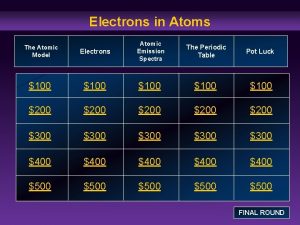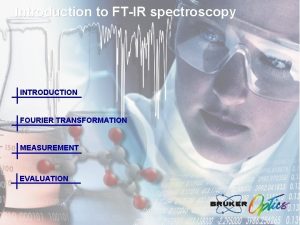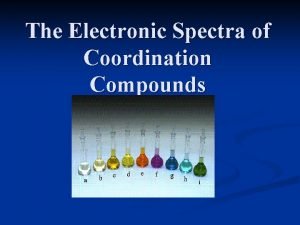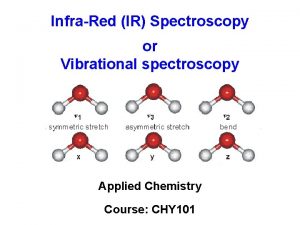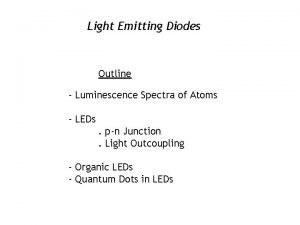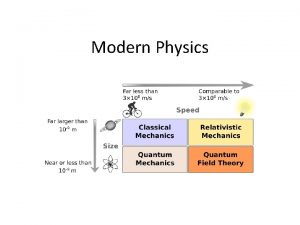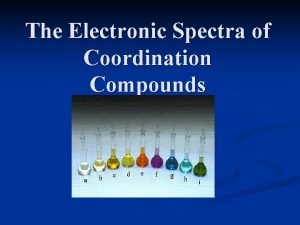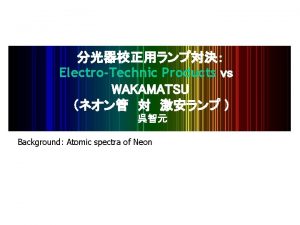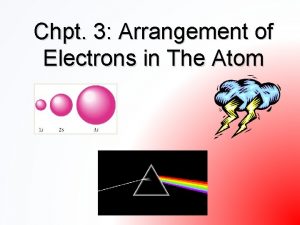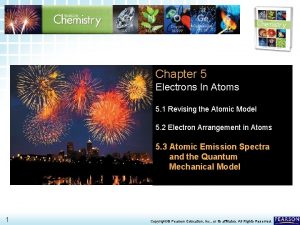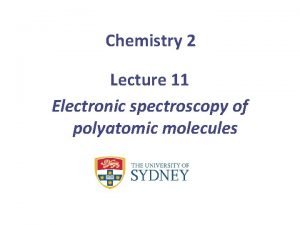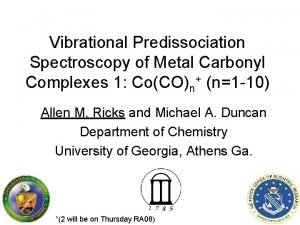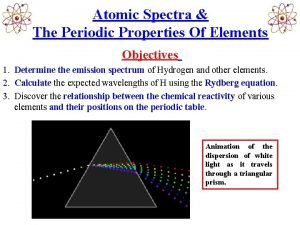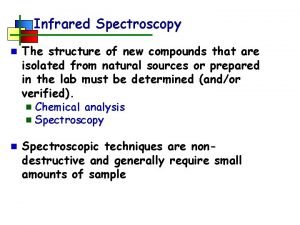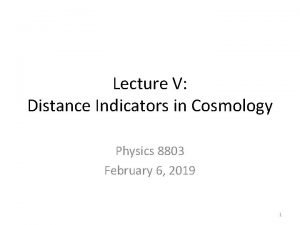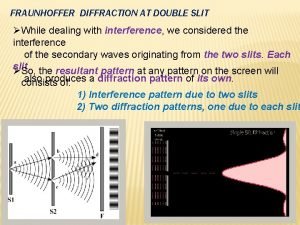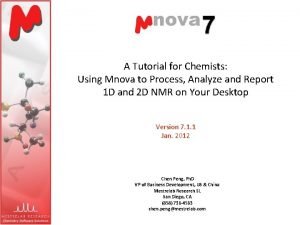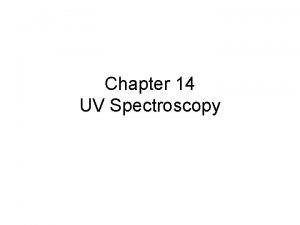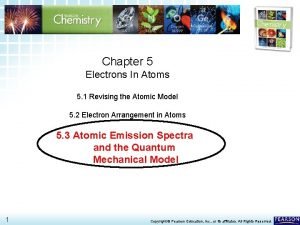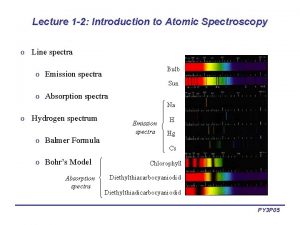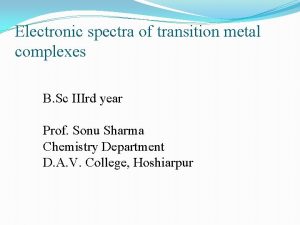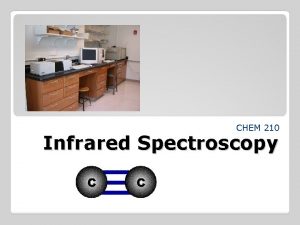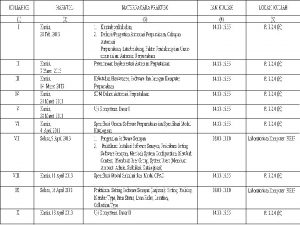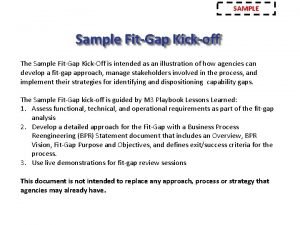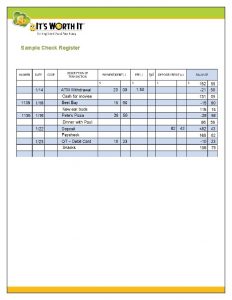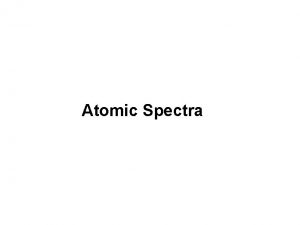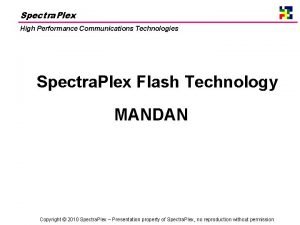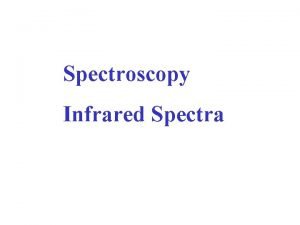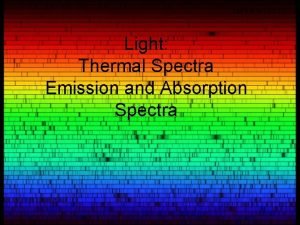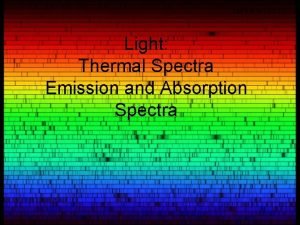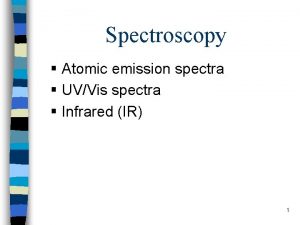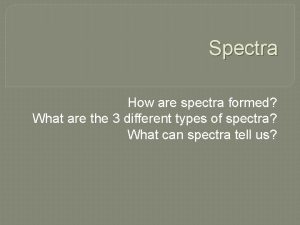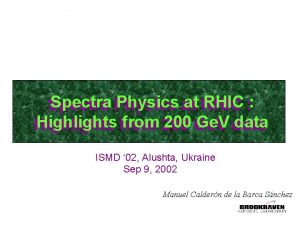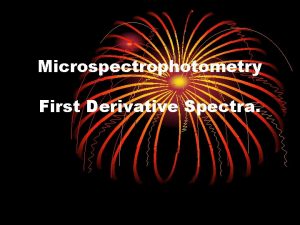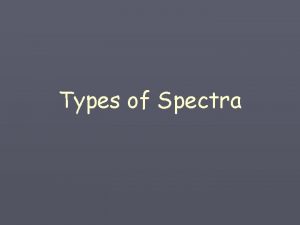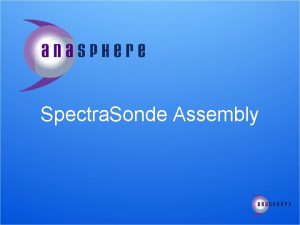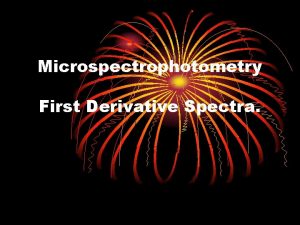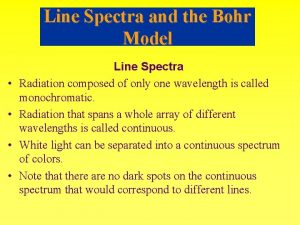Sample Spectra 10202021 1 Sample Spectra 10202021 2


























- Slides: 26

Sample Spectra 10/20/2021 1

Sample Spectra 10/20/2021 2

MALDI TOF MS 10/20/2021 3

Some simple MS spectra CH 3 OH by EI methods (a hard Ionization method) 10/20/2021 4

Some simple MS spectra CH 3 Br, EI ionization (Hard Ionization) 10/20/2021 5

10/20/2021 6

10/20/2021 7

MS Analysis of p-Aminobenzyl Amine Conversion Product 153 – 136= 17 (=NH 3)

Tandem Mass Spectroscopy (MS/Ms) 10/20/2021 9

Description Suppose we analyze a mixture of Components by a soft ionization method (Electron Spray, Chemical ionization). Each component produces characteristic ion species such as [MH]+. The mass spectrum contains peaks for each component. We would like to see structural information for each compontent. 10/20/2021 10

Description The simplest Tandem mass spectrometer contains two MS. The first mass spectrometer is used to select the a single mass (Precursor) mass which is characteristic of one of the components in the mixture. The selected mass ions pass through a region where they are activated in some way that causes them to fall apart to produce fragment (product) ions. 10/20/2021 11

Description This is usually done by colliding the ions with a neutral gas in a process called colldining activation (CA) or collision-induced dissociation (CID). The second mass spectrometer is used to separate the fragment ions according to mass. The ressulting MS/MS spectrum consists only of product ions from the selected precursor. 10/20/2021 12

Kinds of MS/MS experiments Consider a precursor ion, m 1+ that decomposes to produce a product ion, m 2+and a neutral loss , N: m 1+ m 2+ + N MS/MS experiment can be classified according to which of these species is a constant. 10/20/2021 13

Kinds of MS/MS experiments Product ion scan (m 1+ Specified) If we do an MS/MS experiment to find out all of the product ions m 2+ that result from the decomposition of a specified parent ion m 1+, then this is called product ion scan. This is the most common and well known MS/MS experiment. This is used to determine structurally significant fragment ions for a selected precursor ion. 10/20/2021 14

Kinds of MS/MS experiments Precursor ion scan (m 2+ specified) If we perform an MS/MS experiment that tells us all of the possible ions m 1+ that decomposes to a specified parent ions m 1+, then this called a product –ion scan. This is useful hen you know that a product (fragment) ion mass is characteristic of a class o compound, and you would like to identify the mixture components that belong to that compound class. 10/20/2021 15

Kinds of MS/MS experiments Constant neutral loss scan (N specified) An MS/MS experiment that looks for all pairs of precursor ions and product ions that differ by a constant neutral loss, N. then this is called a constant neutral loss scan. This is useful when you know that a particular neutral loss mass is characteristic of a class of compounds and you would like to identify the mixture components that belong to that compound class. 10/20/2021 16

Samples MS/Ms of Quinine, High Energy CID vs. Low Energy CID 10/20/2021 17

10/20/2021 18

10/20/2021 19

MALDI Applications Narrow MMD Hompolymers Broad MMD Homopolymers As a chromatography detector End groups Copolymers Elucidate Polymer structure 10/20/2021 20

Applications Narrow MMD Hompolymers Already seen for PS Better consistent with results of other methods like light scattering and GPC 10/20/2021 21

Applications Broad MMD Homopolymers For polymers with PDI> 1. 2, it has been shown that the results are not consistent with other methods and are not reproducible as well. Solution: fractionation into narrower PDI is recommended by any of available methods such as sequential precipitation, dissolution or GPC. 10/20/2021 22

Applications End groups Copolymers Elucidate Polymer structure 10/20/2021 23

Conclusion MS is a powerful tool for investigation of compounds , small molecules as well as macromolecules including synthetic polymers, natural polymers and biomolecules. This belongs to the complicated instrumental methods. A wide range of methods utilizing sophisticated techniques are developed now useful for many target and detail investigations on macromolecules. Therefore a complete discussion about the all available MS methods is quite out of the scope of the class. 10/20/2021 24

Exercises Write down all the important notes you have learned from MS. Find one recently published article dealing with the analysis of polymers by using one of the MS methods you have seen up to know in the class. (Individually) 10/20/2021 25

THE END 10/20/2021 26
 Atomic emission spectra periodic table
Atomic emission spectra periodic table Introduction to ftir
Introduction to ftir Correlation diagram in coordination chemistry
Correlation diagram in coordination chemistry Structure of carbon dioxide
Structure of carbon dioxide Outline spectra
Outline spectra Line spectra
Line spectra Electronic spectra of coordination compounds
Electronic spectra of coordination compounds Electro-technic products
Electro-technic products Emission line spectra
Emission line spectra Atomic emission spectra and the quantum mechanical model
Atomic emission spectra and the quantum mechanical model Electronic spectra of polyatomic molecules
Electronic spectra of polyatomic molecules Iron carbonyl fe co 5 is
Iron carbonyl fe co 5 is Periodic table of spectra
Periodic table of spectra Ir spectra chart
Ir spectra chart Supernova spectra
Supernova spectra Absent spectra in diffraction grating
Absent spectra in diffraction grating Matter and materials grade 12
Matter and materials grade 12 Mnova stacked spectra
Mnova stacked spectra Spectrum
Spectrum Conjugation in spectroscopy
Conjugation in spectroscopy Azza spectra
Azza spectra Nitro functional group ir spectrum
Nitro functional group ir spectrum Spectra tips
Spectra tips Atomic emission spectra and the quantum mechanical model
Atomic emission spectra and the quantum mechanical model Introduction to atomic spectra
Introduction to atomic spectra What is the mulliken symbols for 'f' spectroscopic term in
What is the mulliken symbols for 'f' spectroscopic term in 1-octyne ir spectrum
1-octyne ir spectrum
